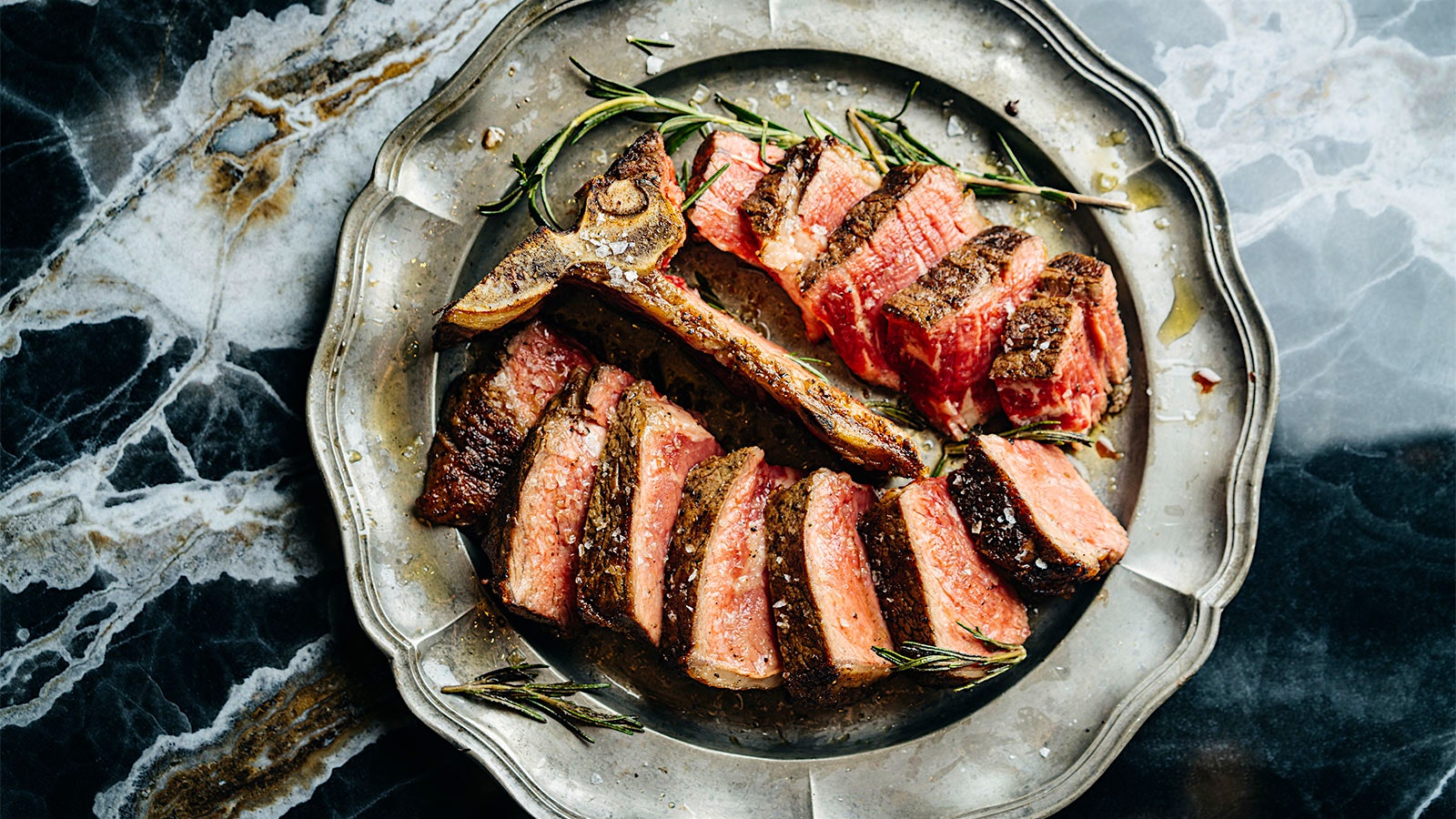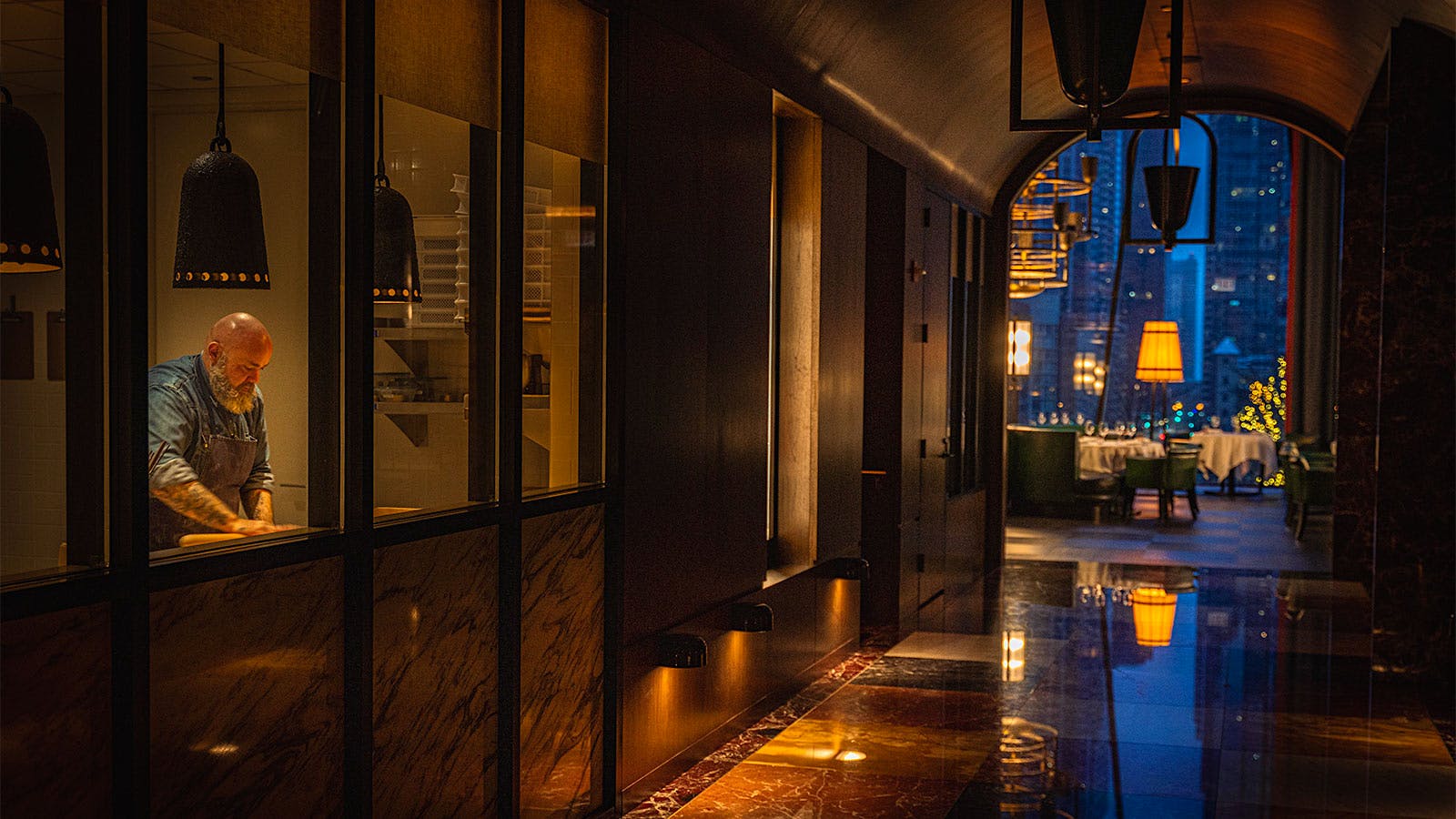Who’s behind it: Tre Dita and the adjoining Bar Tre Dita are new endeavors from Evan Funke, the chef behind Los Angeles restaurants Felix Trattoria, Funke and Mother Wolf. Funke focuses primarily on Italian culinary traditions, particularly handmade pastas, and is the author of 2019 cookbook American Sfoglino. For the Tuscany-focused Tre Dita, he is collaborating for the first time with leading hospitality group Lettuce Entertain You, which oversees a portfolio that includes Wine Spectator Restaurant Award–winning RPM Steak, RPM Italian and RPM Seafood restaurants.
When it opened: Tre Dita and Bar Tre Dita opened on March 16, 2024, on the second floor of the St. Regis Chicago hotel in the Lakeshore East area of Chicago.
The culinary approach: “My inspiration for Tre Dita is drawn from la cucina Toscana and its deeply rooted culinary and cultural traditions with emphasis on both the popularity of Renaissance court cooking and the food of the pastoral communities,” Funke told Wine Spectator via email. (The restaurant’s name, meaning “three fingers,” refers to the ideal thickness of the traditional bistecca alla Fiorentina.)
Dishes include house-made focaccia with rosemary, prawns in a salsa verde and hand-made pastas such as tortelli di zucca and tagliatelle with ragu. Funke and his team prepare many entrées over an open-hearth, wood-fired grill, including swordfish on the bone, roasted chicken with garlic and a bistecca alla Fiorentina. “My hope is that Tre Dita and Bar Tre Dita will be a welcome addition to Chicago,” Funke added.

What’s on the wine list: Wine director Kat Hawkins oversees an Italy-focused list of more than 700 wines. Hawkins emphasizes Italian grape varieties seen less often on wine lists in the United States, such as Lagrein, Schiava and Chiavennasca. “The most thrilling part is using our connections to introduce guests to wines they’ve never encountered before,” said Hawkins.
Guests will find wines from Tuscany, Piedmont, Lombardy, Campania, Sicily and beyond. This includes Montepulciano from Abruzzo’s Emidio Pepe (with vintages from the early 2000s), Amarone della Valpolicella from Veneto’s Romano Dal Forno and several vintages of Fontdodi’s Tuscan red Flaccianello and Antinori’s Toscana Tignanello.
Hawkins’ list also shows significant vertical depth, with multiple vintages of Canalicchio di Sopra Brunello and Gaja Barolo Sperss, among other bottlings. There’s also horizontal breadth, with several wines from Tuscany’s Tua Rita; guests can look to 30 sweet wines (primarily Vin Santos) and nearly 25 large-format bottles as well.

“Focusing solely on selections from one country might feel limiting at first, but through engaging with guests, we’re confident they’ll discover that Italy has it all,” Hawkins explained, noting that Tre Dita will host wine events in the future. “We aim to showcase this diversity with enthusiasm and a sense of adventure, ensuring that every visit is a journey through the best of what Italy has to offer.”
The design: David Collins Studio has designed the 130-seat Tre Dita with sienna, terracotta and gray Tuscan marble elements. The space features columns, archways, wrought-iron lighting fixtures, green banquettes and walnut paneling meant to create a Tuscan atmosphere, as well as picturesque views of Lake Michigan and the Chicago River. The restaurant also features a 40-guest private dining room on its mezzanine.
That’s not all: Adjoining Tre Dita is the 120-seat, walnut-paneled Bar Tre Dita, where bar and spirits director Diane Corcoran serves Italian wines and spirits, as well as Italian-influenced cocktails like the Tre (a mix of Italian gin, grappa and white vermouth), the Dita (a Manhattan made with amaro and vermouth) and the 1871 Bloody Mary (a signature cocktail for the St. Regis Chicago). Corcoran offers about 30 amari, 20 grappas and 20 vermouths. At the bar is a 96-foot-long abstract mural of the Chicago skyline from artist Dean Barger.—Collin Dreizen
Bar Bludorn Debuts in Houston’s Memorial Neighborhood
Who’s behind it: Bar Bludorn is the third project from the trio behind Award of Excellence winners Bludorn and Navy Blue: chef and restaurateur Aaron Bludorn, his wife and partner Victoria Pappas Bludorn and partner–director of operations Cherif Mbodji. A contemporary American bistro, the restaurant brings the group’s signature Texas Gulf Coast dining to Hedwig Village, an independent city in the upscale, suburban Memorial area of western Houston.
The partners aimed to create a friendly, inviting space that “feels uniquely ‘us’ while also [fitting] seamlessly into the fabric of the neighborhood,” according to a statement from Bludorn. The new restaurant is “a continuation of our journey to create inviting spaces that celebrate food, community and hospitality.”

When it opened: Opened March 29 at 9061 Gaylord Drive, Bar Bludorn serves dinner Tuesday through Saturday from 5–10 p.m.
What’s on the wine list: Wine director Molly Austad has assembled a list of 110 bottles and 22 by-the-glass pours, with plans to grow the list over time. There’s particular strength in California and France. “Our selections primarily appeal to Houston’s fondness for robust red wines,” she told Wine Spectator. “The fusion of boutique Napa Valley producers and renowned Bordeaux châteaus sets the stage for a diverse selection that caters to the discerning palate of our clientele.”
While the list boasts celebration-worthy bottles from global stars such as Château Mouton-Rothschild, Opus One and Domaine de la Romanée-Conti, adventurous drinkers will be rewarded by a solid range of sub-$100 bottles like Chablis from Christian Moreau or Dellile’s D2 bottling from Washington’s Columbia Valley. Also of note are a collection of wines from family-run Burgundy domaines and selections from Champagne and the Rhône Valley, joined by offerings from Spain, Portugal, Italy, Austria, Germany and Southern Hemisphere countries.
The beverage program offers plenty for cocktails and spirits lovers: Bludorn alum Fabio Pontes serves distinctive cocktails, including the Hanami, which combines Japanese gin and vodka with plum sake and cherry blossoms to evoke the experience of viewing the ephemeral blooms. A handful of zero-proof options are also sure to please. The spirits list includes single-barrel Bourbons from some of Kentucky’s leading distillers.
The culinary approach: Executive chef and Houston native Alexandra Peña, who worked at both Bludorn and Navy Blue, carries on Bludorn’s signature style with elegant takes on bistro staples. As at Bludorn and Navy Blue, starters include oysters served three ways (raw, baked and fried), along with other dishes like steak tartare and duck gumbo. Entrées include rabbit pappardelle, cornmeal-crusted snapper with black-eyed peas, and fried chicken with peanut butter gravy (a nod to the popular monthly chicken dinners at Bludorn). And there’s no shortage of beef! (This is Texas, after all.) Take your pick of a dry-aged burger, an 8-ounce hanger steak with frites or a 32-ounce tomahawk rib eye.

The design: The 5,000-square-foot space, designed by the architecture firm Gensler, blends puts an upscale twist on the welcoming vibe of a neighborhood tavern. Flanking the dining room are a bar on one end and an open kitchen on the other. Walnut paneling and a slatted wood ceiling contribute to the intimate, cozy vibe.
In conjunction with the gallery Reeves Art + Design, Bludorn chose paintings and prints by Houston artists to adorn the space. The art on display includes three paintings by David Adickes, the 97-year-old celebrated local artist best known for A Tribute to Courage, his 67-foot-tall statue of Texas historical figure Sam Houston, which is visible from Interstate 45 in Huntsville, Texas north of Houston.—Kenny Martin
Sempre Oggi Opens on Manhattan’s Upper West Side
Who’s behind it: Sempre Oggi (meaning “always today”) is a new restaurant from Robert Guarino, co-owner of Wine Spectator Award of Excellence winners Marseille and Nizza, as well two Five Napkin Burger restaurants on Manhattan.
“The main inspiration for Sempre Oggi was to create a restaurant that truly celebrates the seasons,” Guarino told Wine Spectator via email. “I find the most memorable dining experiences to be in restaurants that change their menu every day.”
When it opened: Sempre Oggi opened in January on Manhattan’s Upper West Side, at 164 West 75th Street, the former location of now-closed Cesca.
The culinary approach: Chef Phillip Basone, formerly executive chef at Jonathan Waxman’s Barbuto in the West Village and chef de cuisine at Award of Excellence winner Le Crocodile, prepares seasonal, modern Italian cuisine. Dishes include mashed fava beans, escarole salad, almond-crusted halibut, fluke crudo and house-made focaccia as well as hand-made pastas like rigatoni with rabbit ragu, spaccatelli with swordfish and bigoli with duck leg ragu.

What’s on the wine list: Italy makes up 60 percent of wine director Gabe Richter’s 100-label program (representing an 800-bottle inventory). “I look for wines that complement our chef’s food,” said Richter, “moderate-alcohol, moderate-oak, energetic and expressive wines that are ready to enjoy now.” Guests can expect Lambrusco and Prosecco for bubbles, as well as Gavi, Soave, Barolo, Amarone, Chianti Classico, Etna and more (including several skin-contact wines). The list features well-known wineries such as Piedmont’s Michele Chiarlo and Roagna, Sicily’s Passopisciaro and Tuscany’s Querciabella.
“Most of the list is focused on producers that are farming or sourcing organic or biodynamic fruit,” Richter explained. “We don’t require them to be certified, but prefer to see native-yeast fermentations and low use of sulfur. Most of the Italian wines are also made from indigenous Italian grapes.”
Wines from France and California include Champagnes, Burgundies, Bordeaux and Napa Valley Chardonnays and Cabernets. Richter plans to expand the list to 130 or 150 wines, but wants to keep the selection “approachable and tightly curated.”
”The response to the wine program has been very positive,” said Richter, who hopes to host wine-focused dinners. “Sempre Oggi is bringing something to the Upper West Side neighborhood that really doesn’t exist here, and I’m proud to be a part of that.”

The design: Eamon Roche of Roche Modern designed the 150-seat restaurant to “make diners feel as if they are in the home of their impossibly chic Milanese friend,” as described in a statement from the Sempre Oggi team. The 15-seat bar space features a ceiling lined with handmade tiles.
The neighborhood: Just off Amsterdam Avenue, Sempre Oggi isn’t far from the famed Beacon Theatre and is only a few blocks from Verdi Square and the American Museum of Natural History. It’s also close to Central Park and the ever-popular Levain Bakery.
“Every element of Sempre Oggi was thought through with our Upper West Side neighborhood in mind,” said Guarino. “I am excited to try to make this restaurant one of the mainstays of uptown dining.”—C.D.
